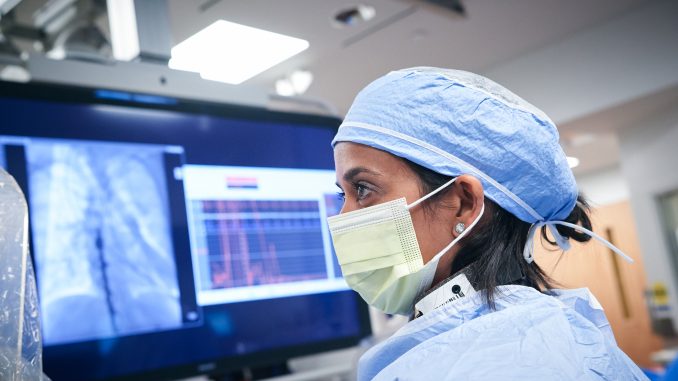
Delivering health care remotely sounds undesirable, unless patients are hesitant to attend in person appointments from fear of contracting COVID-19.
Anjali Vaidya and her colleagues released the virtual echocardiography screening tool, a method of reading heart ultrasounds to identify pulmonary hypertension symptoms, on Sept. 17.
VEST reduces the time needed to identify cases of PH by widening the range of doctors who can interpret signs of PH. It is one of the virtual medicine technologies being used by Temple University Hospital to reduce COVID-19 exposure during the pandemic. VEST uses previous ultrasound reports instead of in-person assessments, said Vaidya, co-director of the pulmonary hypertension program at the Lewis Katz School of Medicine.
PH is a heart disease caused by high blood pressure in vessels connecting the lungs to the heart, which can lead to heart failure, according to the Centers for Disease Control and Prevention.
Accurate diagnosis can take two or three years and requires a cardiology specialist, Vaidya said.
VEST is a system of reading echocardiograms, or heart ultrasound, reports and giving “scores” to certain indicators of PH, said Paul Forfia, co-director of Temple’s program. Based on the score, doctors who don’t specialize in PH can figure out the likelihood a patient has PH.
“What we’re trying to do is basically provide a tool so that they can extract the relevant information from an echo report,” Forfia said. “You don’t have to know how to read an echo, all you have to know is how to read.’”
Before VEST, patients would have to be referred to a PH specialist and often undergo a surgery called right heart catheterization in order to be diagnosed, a multiple year long process Vaidya said. With more doctors able to identify risk factors, the time needed to identify and diagnose PH is reduced.
“By the time they are referred or I meet them, often they’ve been suffering for so long,” Vaidya added.
Before, doctors who are not experts in PH would often miss a case because they don’t know what abnormalities indicate the disease, Forfia said. Now, the VEST method makes abnormalities “jump off the page,” he added.
Patients being assessed for PH have often already undergone heart ultrasounds, and VEST uses these reports instead of requiring them to come to the hospital for further assessments.
In April, more than 43 percent of all Medicare primary care visits were being conducted through telehealth, an increase from 0.1 percent in February 2020, according to the American Hospital Association. Telehealth is defined by the Department of Health and Human Services as using electronic information and communication to provide healthcare.
The VEST report was completed 5 years ago, said Forfia, but did not get published because reviewers didn’t understand its relevance to PH. When the COVID-19 pandemic hit, Vaidya and Forfia resubmitted the report, and it got accepted because of its contactless PH diagnoses.
“I had clinic patients today that said they’re terrified of doing anything in person,” Vaidya said. “It doesn’t mean that they won’t have to be seen ever, but it will just help recognize the presence of this disease sooner.”
Patients with PH often have underlying heart or lung disease and many are older and immunocompromised, making them at a higher risk for COVID-19, Vaidya said.
“It’s a safer kind of telemedicine, but still accurate way to do it than previously,” Vaidya said. “I think the patients certainly have the potential to benefit from this for many perspectives.”
Tony Reed, chief medical officer of Temple University Health Systems, said telemedicine has increased accessibility and convenience for many patients and helps providers stay on schedule.
In February, Temple University Hospital had almost zero telemedicine visits, but since March, almost 90,000 patients were treated using telemedicine, David Fleece, chief medical information officer wrote in an email to The Temple News.
Though hospitals will likely never stop conducting in-person visits, Reed does expect to see continued advancements to telemedicine in the future.
“I think we will see the technology continue to evolve and to flourish,” Reed said. “I don’t know where it will land, but I know that the landscape will look completely different than it did a year ago.”



Be the first to comment